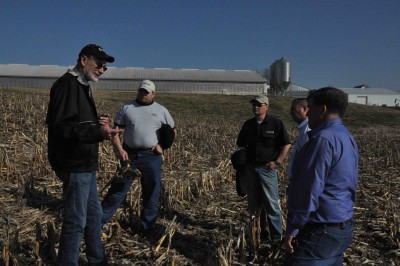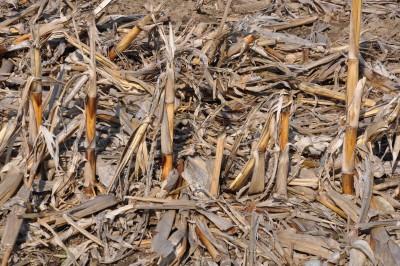With ongoing attention on using corn stover to fuel cellulosic ethanol production, many people wonder how much residue can be removed before “robbing” the soil of nutrients, as well as organic matter. Like so many issues in agriculture, university and agri-business experts say a number of factors affect this decision.
But it’s farmers like Roger Zylstra of Lynnville, Iowa, who will ultimately decide whether to harvest corn stover and, if so, how much to remove from their fields.
Zylstra makes clear that as a board member of the Iowa Corn Growers Association he not only supports corn-based ethanol, but also ethanol produced from cellulose.
“We need ethanol that’s produced from cellulose to increase ethanol’s use beyond 15 billion gallons per year that’s made from corn,” he says.
Zylstra farms about 900 acres, which includes highly erodible land (HEL). While he’s essentially in a 50-50 corn-soybean rotation, he’s considering going to two years of corn, followed by a year of soybeans on HEL ground.
“It may be some of the non-highly erodible land that we can take off some stover,” Zylstra says. “We’re looking at going to a corn-corn-soybean rotation on HEL, using a vertical tillage tool to do minimal tillage 1 of the 3 years in the rotation.”
Years ago, dairy and beef cattle farmers in Zylstra’s area chopped corn silage every year, removing far more biomass than is being proposed for cellulosic ethanol.
 Iowa farmer Roger Zylstra, left, supports ethanol made from corn and from cellulose, but is cautious about how much stover could be removed from his fields. Here Zylstra and his son, Wes, center, visit with the Oregon Ryegrass Commission's officers — from left to right — Guy Lewis, Denver Pugh and Brian Glaser. (Photo courtesy Oregon Ryegrass Commission) |
“While we chopped silage, we also hauled a lot of nutrients back onto the fields with manure,” he says.
Three Critical Issues
With corn stover removal, the three critical issues to factor in are soil erosion, fertility values of the stover and soil organic matter, says Andy Heggenstaller, Pioneer Hi-Bred’s agronomy research manager, cellulosic ethanol, Johnston, Iowa.
“If we manage stover removal to sustain the organic matter in the soil, then enough residue will be left so that soil erosion should not be a problem,” Heggenstaller says. “In fact, leaving that level of stover should be more than enough to protect the soil. If we know how much fertilizer — nitrogen, phosphorus and potassium — we’re removing with the corn stover, that just becomes part of the economic value consideration for the farmer.”
Yield, tillage and crop rotation affect how much stover can be removed, Heggenstaller says.
“Based on our research and other studies, we believe that corn fields that yield at least 175-180 bushels per acre are the ones where corn stover can be removed without taking too much to sustain the soil,” he says. “Below that yield level, there’s not enough crop residue.”
Farmers need to be careful about removing corn stover in a corn-soybean rotation, especially if they use intensive tillage, Heggenstaller says.
Based on research by the Univ. of Nebraska and the USDA’s National Laboratory for Agriculture and the Environment in Iowa, farmers in the Cornbelt can remove 2 tons of stover per acre in continuous corn where conservation tillage or no-till are used, Heggenstaller says.
“Removing 2 tons of stover in this cropping system should not deplete soil organic matter, and, in fact, there can be benefits, such as faster soil warm-up the following spring,” he says.
But in a corn-soybean rotation with conservation tillage or no-till, only 0.84 tons of stover per acre can be removed each year without risking depletion of soil organic matter, Heggenstaller says.
“In a corn-soybean rotation, we recommend harvesting 2 tons of corn stover only 2 of every 5 corn years to prevent loss of soil organic matter,” he says.
It’s essential for companies that want to sustain the production of cellulosic ethanol from corn stover to have a reliable supply of large volumes year in and year out, Heggenstaller says. That means securing enough stover to feed a plant in any given year, but also ensuring long-term sustainability for farmers.
DuPont, which owns Pioneer Hi-Bred, is developing an ethanol plant in Iowa that will produce about 25 million gallons of cellulosic ethanol a year when fully operational. To produce that amount of ethanol, the plant will use 300,000 tons of stover a year, which is roughly 600,000 corn stover bales that are each 3 x 4 x 8 feet, Heggenstaller says.
Nutrients in Stover
Often times, nutrient values reported for the nitrogen, phosphorus and potassium contained in stover are based on a corn plant at physiological maturity, Heggenstaller says. But samples that DuPont and Iowa State took from large bales of corn stover in the fall of 2010 revealed less nitrogen, phosphorus and potassium in harvested stover than what is typically reported for corn plants at physiological maturity.
“Potassium, in particular, can leach out of the stover,” Heggenstaller says. “This can happen even in standing corn that hasn’t been harvested, particularly when it rains. In general, nutrients tend to move down to the bottom of the plant after maturity and can leach even if they aren’t rained on. In our research, the amount of potassium — K20 — dropped in half between September 25 and November 15, from 1.5% to about 0.75%.
Potassium is the only one of the three nutrients that is in a mineral form in the stover and, therefore, the only nutrient that should readily leach, Heggenstaller says.
"From the work we did in 2010 with professor Matt Darr of Iowa State Univ., who is in the Agricultural and Biosystems Engineering Dept., we also observed somewhat less nitrogen and phosphorus in the stover relative to what is generally reported for mature corn plants. These declines are something we are continuing to evaluate.”
Removing corn stover does take nutrients from the field, but the exact amount is not set in stone, Heggenstaller says. The samples Pioneer and Iowa State collected from large bales in the test harvests showed that, on average, each ton of stover contained about 10 pounds of nitrogen, 5 pounds of phosphorus — P205 — and 25 pounds of potassium — K20. This is the oxide — not the elemental — form of phosphorus and potassium, he notes
These test results provide two key guidelines for stover removal, Heggenstaller says.
 Stover removal may be possible on some of the non highly erodible land that Roger Zylstra farms in central Iowa. (Photo courtesy Oregon Ryegrass Commission) |
“First, we’re taking very little phosphorus off in the long term,” he says. “Secondly, farmers and those making fertilizer recommendations will need to pay close attention to the levels of potassium in the soil in a scenario where stover is harvested on a regular basis.”
Less Stover, More Nitrogen
Emerson Nafziger, Univ. of Illinois corn agronomist, says in a 6-year study he and others did on nitrogen response in cropping systems with tillage, there was no difference in responses where fields were tilled vs. those where the stover was removed.
“If you’re no-tilling in a corn-soybean rotation, you could remove 1-2 tons of corn stover without creating a serious soil erosion problem,” Nafziger says. “From a soils standpoint, for both organic matter and from soil organic carbon, soybeans do not hold up their end, if you remove corn stover in a corn-soybean rotation that could deplete organic matter and carbon.”
Not many Illinois farmers no-till continuous corn, Nafziger notes.
“But if you are, taking residue off makes that system work better,” he says. “If you leave all of the residue in the fields and try to no-till continuous corn it takes more nitrogen and yields are lower. Almost everyone in Illinois tills in continuous corn.”
Field Slope Matters
Steve Petersen, Monsanto’s end-use market manager, Chelsea, Iowa, says as long as corn yields are adequate, the number one factor in stover removal is the slope of the field.
“You can remove stover sustainably, but it depends on the slope, tillage, whether you’re growing continuous corn and the yield,” Petersen says. “And in western Nebraska and in Kansas, wind erosion becomes a big issue.
“At Monsanto, we have talked about doubling corn yields by 2030,” Petersen says. “Growers have said, ‘That’s great, but what’s going to happen with all that stover? We already have plenty with 200 bushel-per-acre corn.’”
Using the USDA’s RUSLE2 (Revised Universal Soil Loss Equation) and the soil-conditioning index (SCI), Monsanto set corn stover baling targets in each field baled to have less than 2.5 tons of soil erosion per acre. That’s a relatively small amount of erosion, he notes.
“Under these conditions, corn growers would still be adding enough organic matter and carbon to the soil,” Petersen says. “We don’t want to put a burden on the soil by removing too much carbon.”
In a 2008-2011 study that Deere, ADM and Monsanto conducted in Iowa, farmers were paid an average of $10 based on ISU fertilizer prices for the value of the nitrogen, phosphorus and potassium measured in the average 1,200-pound bale of stover, plus a $7.50 profit per bale.
“A lot of that value is from the nitrogen removed, as well as the phosphorus and the potassium,” Petersen says. “But if you don’t remove that residue, then it takes nitrogen to break down the corn stalks. Removing a sustainable amount of stover saves farmers tillage trips, along with fuel, time and wear on machinery.”
Petersen notes that farmers in the Cornbelt have long baled cornstalks for both bedding and feeding. In a similar vein, Iowa State Univ. professor of soil fertility John Sawyer points out that corn has been chopped off for silage for years.
“Corn silage takes more biomass off than what’s being discussed for cellulosic ethanol,” Sawyer says.
He recommends that farmers consider not only the short-term impact of nutrient removal in stover on next year’s crop, but also the long-term impact of reducing soil carbon. And that effect may not be noticed for many years.
Sawyer and Iowa State Univ. professors Antonio Mallarino and Mahdi Al-Kaisi have completed 3 years of research on the impact of stover removal on yield and nitrogen fertilization requirement in continuous corn. Their research shows a small yield benefit from removing stover, as well as a reduction in the amount of nitrogen application needed. That is a short-term perspective, and the longer-term impact on nitrogen fertilization requirement may be different.
Carbon Value
“When you remove biomass, there’s less carbon for soil cycling,” Sawyer says. “So you’re having a long-term impact on the amount of carbon for microbial processing and potential to remain in the soil. But the more biomass you remove, the less cycles through the soil, which is more critical in a soybean rotation. Different soils are more fragile and are more erosive or need more crop residue returned to protect the soil surface or to maintain soil organic matter.”
While nutrients in corn stover have an economic value and carbon is needed for cycling through the soil, keeping all of the residue has not always been a goal, the Univ. of Illinois’s Nafziger notes.
“In fact, when there’s been too much crop residue to deal with, people historically have tended to burn it off,” he says. “That leaves the mineral nutrients like phosphorus and potassium behind and reduces nitrogen tie up. We won’t be recommending burning, of course. But we do have the ability to remove residue and not reduce soil productivity — if we do it carefully.”
Dealer Takeaways– Sustainable corn stover removal depends on field slope, tillage, crop rotation and yield. – The important thing to keep in mind about stover nutrient values is to look at how and when the stover was harvested. – Stover removal can produce some benefit in no-tilled continuous corn. |






